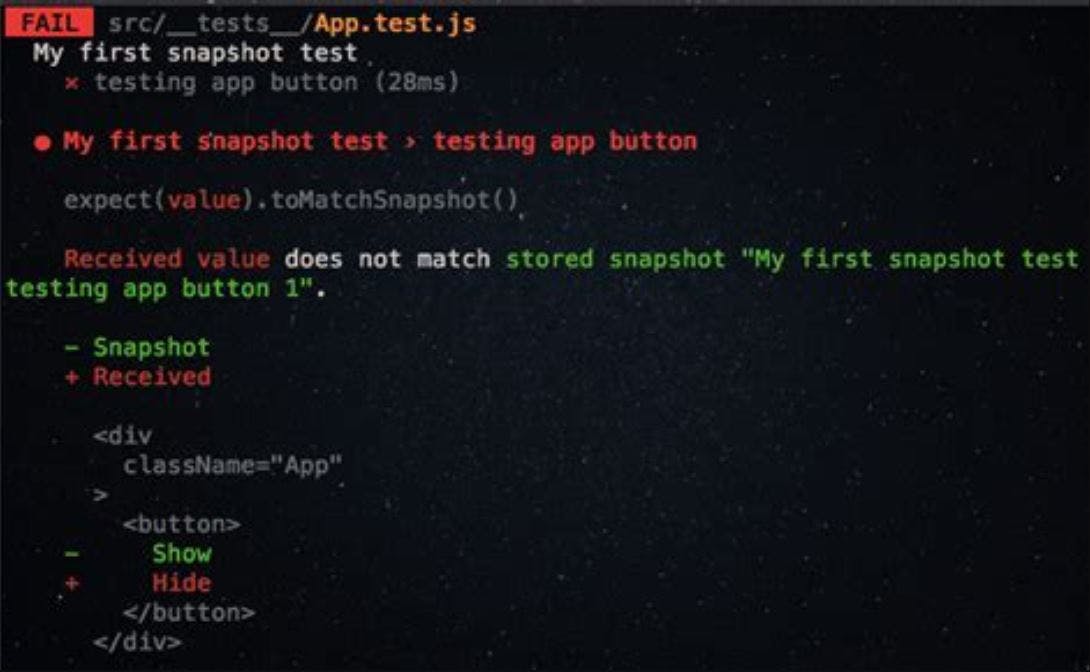Testing is the process of evaluating a system or its component(s) with the intent to find whether it satisfies the specified requirements or not. In simple words, testing is executing a system in order to identify any gaps, errors, or missing requirements in contrary to the actual requirements.
The React community has produced a large number of libraries for testing components and functions in React applications.
You need to test because you will have:
- Quality Code: You are sure that the code does what we expect.
- Design focus on the needs: You understand the requirements, you design based on that, and you build thinking on that.
- Less debugging more coding: With more test, fewer errors you will have and you can focus on the more complicated and funny tasks.

Jest
Jest is the testing framework used at Facebook to test React components and is adopted by Uber, Airbnb and other teams.
The React community, therefore, recommends Jest as the React testing framework of choice. Jest itself works with many JavaScript projects our of the box, from create-react-app to NG, Vue and even TS or Babel.
This framework is also good for beginners who want to try incredibly fast JavaScript codes.
- Very fast performance. Airbnb saw a decrease in the total test runtime from 12 minutes to only 4.5 minutes when they switched from Mocha to Jest.
- It conduct snapshot, parallelization, and async method tests.
- Mock your functions, including third-party node_module libraries
- Possible to manage tests with larger objects using live snapshots.
- Standard syntax with report guide.
- Compatible with React, VueJS, Angular and many projects.
Mocha
Mocha is a JavaScript test framework for Node.js programs, featuring browser support, asynchronous testing, test coverage reports, and use of any assertion library.
It is very configurable and gives the developer full control over how they wish to test their code, with which tools, while you can plug in and out most supporting libraries and tools in your chain.
- Mocha runs on Node.js and provides support for asynchronous front-end and back-end testing
- Helps in error tracking.
- Combination of Mocha with Enzyme and Chai is popular for the assertion, mocking, etc. Enzyme + Mocha is a good combination to test web applications written in ReactJS.
Enzyme
It is designed to help developers for testing the React component without any hassle. Besides, it is one of the most used frameworks developed and maintained by Airbnb.
Furthermore, Developers combine it with other frameworks such as Jest, Chai, or Mocha to test the React application.
The enzyme is only used to render components, access things, find elements, interacting with elements, and simulate events.
Jasmine
Jasmine is a simple JavaScript testing framework for browsers and Node.js. Jasmine follows a behavior-driven-development pattern, so configuration is generally in place before use.
With Jasmine, developers can test for the visibility and resolution of user interfaces on different devices.
To use Jasmine in testing React applications, developers can add other third-party frameworks such as Enzyme.
Pros of Jasmine include the following:
- Does not require DOM to test
- Can be used for frontend and backend tests
- Can be used for asynchronous function tests
- Features a custom equality checker assertion
- Comes with an inbuilt matcher assertion

Cypress IO
Cypress is a JavaScript end-to-end testing framework that makes it easy to setup, write, run and debug tests in the browser.
It comes with its own dashboard that gives control over the status of our tests, and, because Cypress works in the actual browser, you can use the browser’s dev tools side-by-side.
With built-in parallelization and load balancing, Debugging tests in CI becomes much that easier too. However, you can’t use Cypress to drive two browsers at the same time, which might hurt.
Puppeteer
Puppeteer is not a javascript framework, it is a headless Chromium Node library that provides API to control Chrome or Chromium through the DevTools protocol.
You can start chromium and, with the provided API, navigate between pages, get buttons, and click on them.
Puppeteer runs on an actual browser and it allows you to write end-to-end tests with an API similar to the browser.
You can do many more things with Puppeteer such as generating screenshots, generating pre-rendered content from SPAs, automating actions like form submissions, keyboard inputs, etc.
You can combine Puppeteer with Jest to test your React application end to end.
